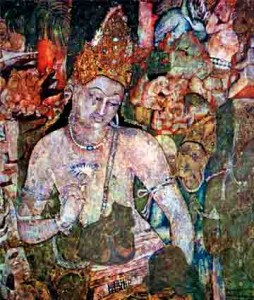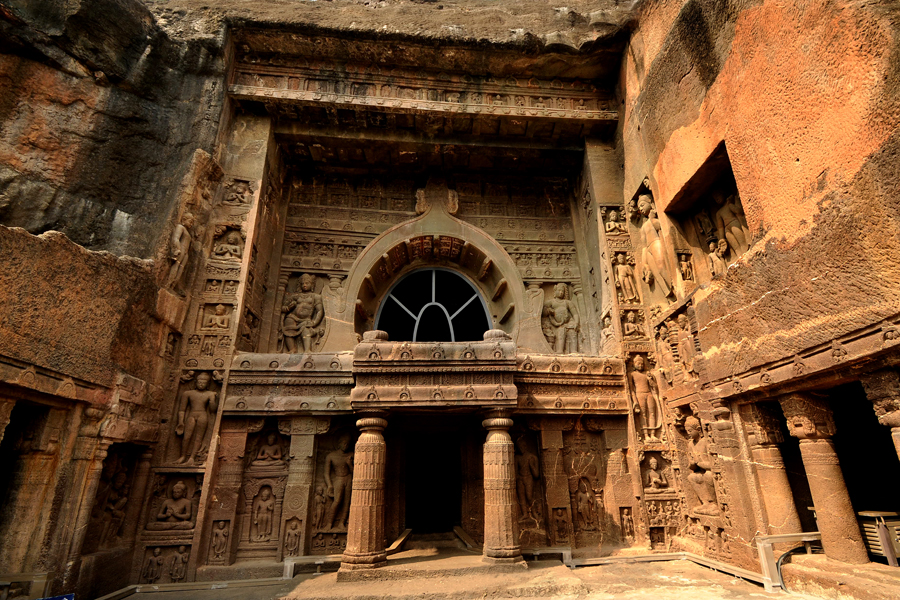- In the western India, many Buddhist caves dating back to the second century BCE onwards have been excavated.
- Mainly three architectural types were executed:
- Apsidal vault-roof chaitya hall (found at Ajanta, Pitalkhora, Bhaja),
- Apsidal vault-roof pillar-less hall (found at Thana-Nadsur)
- Flat roofed quadrangular hall with a circular chamber at the back (found at Kondivite)
- In all the chaitya caves, a stupa at the back is common.
- In the first century BCE, some modifications were made to the standard plan of the apsidal vault-roof variety where the hall becomes rectangular with a stone screen wall as facade.
- The biggest rock cur chaitya hall was excavated in Karla, Maharashtra.
- Viharas are excavated in all the caves.
- The plan of vihara consists of a veranda, a hall and cells around the walls of the hall.
- Many of the early vihara caves are carved with interior decorative motifs like chaitya arches and the vedika designs over the cell doors of the cave.
- A stupa was added in the back of the vihara in the later period and it became Chaitya- Vihara.
- Junnar (Maharashtra) has the largest cave excavations – more than 200 caves around the hills of the town – whereas Kanheri in Mumbai has a hundred and eight excavated caves.
- Vihara cave excavated at Junnar is popularly known as Ganeshi because of an image of Ganesh belonging to a later period was installed in it.
- Earlier it was believed that because of the absence of the Buddha images, the caves were considered belonging to the orthodox faith of Buddhism, Theravadins.
- But with the discovery of Konkan Maurya inscription mentioning the Saka era 322 (400CE), it is now satisfactorily proved that the caves activity in western Deccan was an ongoing process and many caves had been carved with Buddha image where the image does not exist anymore.
- It may also be noted that many caves are converted into modern Hindu shrines and have become popular worship sites.
Ajanta:
- The famous cave site in western India is Ajanta.
- It is located in Aurangabad district of Maharashtra.
- It has 29 caves, including 4 chaitya caves.
- It has the large Chaitya-Vihara and is decorated with sculpture and paintings (murals).
- Ajanta is the only surviving example of the painting of the first century BCE and the fifth century BCE.
- Some of the vihara caves here are unfinished.
- The important patrons of Ajanta were Varahadeva, the Prime Minister of Vakataka king Harisena; Upendragupta, the local king of the region and feudatory of Harisena; Buddhabadra and Mathurasena.
- Major paintings are in cave Nos. 1, 2, 16 and 17.
- The paintings have a lot of typological variations.
- Figures in the paintings are heavy like the sculptures of western India.
- Cave excavation and painting were a simultaneous process and dating of the paintings follows the date of the cave excavation.
- Almost in all the finished excavations, pictures have been painted, but very few have survived.
- Various skin colours in the paintings represent multi-coloured society.
- The themes of the paintings are events from the life of Buddha, the Jatakas and Avadanas.
- Events happened in the jungle and events happened in the palace are separated by their locations.
- Images of Padmapani and Vajrapani are very common in Ajanta.
PADMAPANI BODHISATTVA
- It is a painting which dates back to the late first century CE.
- The Bodhisattva is holding a padma (Lotus) has large shoulders and has three bents in the body creating a movement in the picture space.

- The modelling is soft and the outlines are merged with the body volume, creating the effects of three-dimensionality.
- Light red, brown, green and blue colours are used in the picture.
- On the other side of the image, Vajrapani Bodhisattva has been painted.
- He holds a vajra in his right hand and wears a crown.
- Bodhisattvas are painted as shrine guardians
- Similar pictures can be seen in other caves too. However pictures in cave no.1 are among the best survived paintings of Ajanta.
MARA VIJAYA, AJANTA CAVE NO. 26
- The theme of Mara Vijaya has been painted in the caves of Ajanta, but only cave no.26 has a sculptural representation, sculpted on the right wall.
- The panel shows the image of the Buddha in the centre, surrounded by Mara’s army.
- The event is the part of enlightenment and Mara represents desire.
- It is the personification of mind which the Buddha went through at the time of enlightenment.
- The Buddha is shown with his right hand indicating towards the earth as a witness to his generosity.
- The image of Mara is shown contemplating how to disturb Siddhartha, the name of Buddha before enlightenment.
Ellora:
- Another important cave site located in Aurangabad is Ellora.
- It is located 100kms away from Ajanta.
- There are 32 Buddhist, Brahamanical and Jain caves.
- It is unique art historic site in the country as it has monasteries associated with the three religions dating from fifth century CE onwards to eleventh century CE.
- It is also unique in terms of stylistic eclecticism, i.e., the confluence of many styles at one place.
- There are 12 Buddhist caves having many images belonging to Vajrayana Buddhism.
- Buddhist caves are big in size and are of a single, double and triple storey.
- The triple storey of Ellora is a unique one.
- Pillar designs grow from Buddhist caves and when they reach Jain caves (9th century CE), they become very ornate and the decorative forms gain heavy protrusion.
- Most of the caves of Brahamanical faith are dedicated to Shaivism.
- The different avatars of Vishnu are also depicted here.
- Cave no.16 is known as Kailas Leni/ kailasa temple.
- It is a rock cut temple which is carved out of a single rock.
- It was built in the 8th century CE.
- The grand sculpture of Ravana attempting to lift Mount Kailash, with his full might is a landmark in Indian art.
Elephanta caves and other sites:
- Elephanta caves located on Elephanta Island near Mumbai were originally a Buddhist site which was later dominated by the shaivite faith.
- It is contemporary with Ellora.
- The other noteworthy cave site is Bagh located near Indore, MP.
- The Bagh cave also contains paintings and a painting which represents a group of dancers resembles the Garba Dance of North India (originated in Gujarat).
- The tradition of rock-cut cave continued in the Deccan and they are found not only in Maharashtra but also in Karnataka, mainly at Badami and Aihole, executed under the patronage of the Chalukyas; in Andhra Pradesh in the area of Vijayawada; and in Tamil Nadu, mainly at Mahabalipuram, under the patronage of the Pallavas.
- When the early history of the country depends on collective public patronage, the post sixth century CE depends more on political patronage.
- The sculpture of Maheshmurti (Shiva at centre and heads of Bhairava and Uma on either side) is located here.
Cave tradition in Eastern India
- Like in western India, Buddhist caves have been excavated in eastern India, mainly in the coastal regions of Andhra Pradesh and Odisha.
- One of the main sites in Andhra Pradesh is Guntapalle in Eluru district.
- Guntapalle is among unique sites where the structural stupas, viharas and the caves are excavated at one place.
- Apart from Guntapalle, the other important site is Rampaerrampallam.
- In Ankapalli, near Vishakapattanam, a huge rock-cut stupa was carved out of the hillock during 4th-5th century CE.
- It is a unique site as it has the biggest rock cut stupas in the country.
- Another important cave site is the Udayagiri-Khandagiri caves located in Odisha.
- These caves are scattered and have inscriptions of Kaharvela Kings.
- According to the inscription, the caves were meant for Jain monks.
- There are numerous single cell excavations here.
- The upper part of the cell is decorated with a series of Chaitya arches and narratives that still continue in the folklores of the region.
Early Temples
- While construction of stupas continued, Brahmanical temples and images of gods also started getting constructed.
- Myths mentioned in the Puranas became part of narrative representation.
- Each temple had a principal image of god.
- The shrines of the temple were three kinds:
- Sandhara type: with pradakshinapatha.
- Nirandara type: without pradakshinapatha.
- Sarvatobhadra type: which can accessed from all sides.
- Some of the important temple sites of this period are Deogarh (UP), Eran, Nacha-kuthara and Udayagiri near Vidisha in MP, etc.
- These temples are simple structures consisting of a veranda, a hall and a shrine at the rear.

Comments
Post a Comment